by Bruce Wells | Jun 4, 2025 | Petroleum Pioneers
Drilling for water in 1894, Corsicana discovered an oilfield and became the richest town in Texas.
In the summer of 1894, town leaders of Corsicana, Texas, hired a contractor to drill a water well on 12th Street. The driller found oil instead. The small community’s oilfield discovery launched the first Texas oil boom seven years before a more famous gusher at Spindletop Hill far to the southeast.
Corsicana’s first oil well produced less than three barrels of oil a day, but it quickly transformed the sleepy agricultural town into a petroleum and industrial center. The discovery launched industries, including service companies and manufacturers of the newly invented rotary drilling rig.
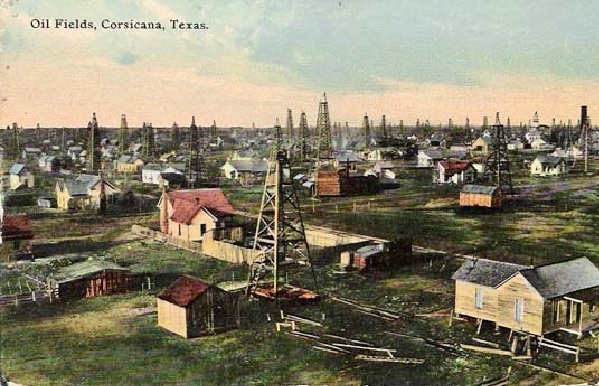
The first Texas oil boom arrived in 1894 with discovery of the Corsicana oilfield by a drilling contractor hired by the city to find water. An annual Derrick Day Chili & BBQ Cook-Off celebrates the discovery. Colorized postcard of Navarro County oil wells, circa 1910.
Corsicana local historians consider the 1894 discovery well, drilled on South 12th Street, the first significant commercial oil discovery west of the Mississippi (Kansans claim the same distinction for an 1892 Neodesha oil well).
Early Texas Oilfields
The American Well and Prospecting Company (from Kansas) made the oil strike on June 9, 1894, at a depth of 1,035 feet. The city council — angry and still wanting water for its growing community 55 miles south of Dallas — paid only half of the drilling contractor’s $1,000 fee. (more…)
by Bruce Wells | Jun 2, 2025 | This Week in Petroleum History
June 2, 1908 – Goose Creek Oilfield discovered –
Drilled on Galveston Bay wetlands, the first offshore well in Texas revealed a giant oilfield 20 miles southeast of Houston, according to the Texas State Historical Association (TSHA). Inspired by reports of bubbles on the surface where Goose Creek emptied into the bay, the Houston-based syndicate Goose Creek Production Company made the discovery at a depth of 1,600 feet.
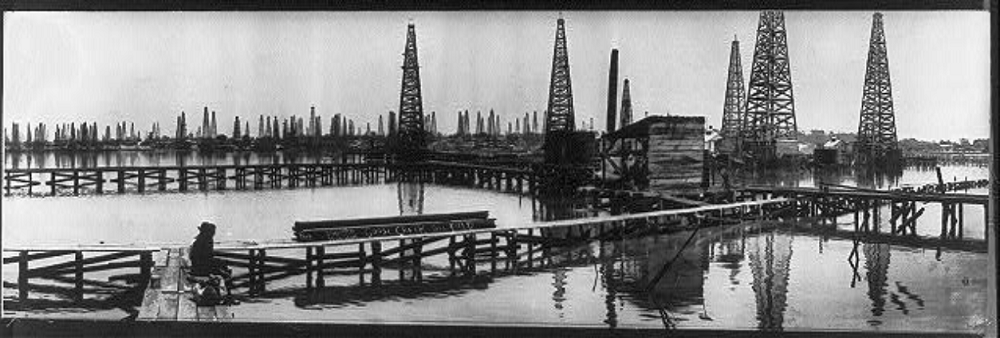
A single well of the Goose Creek field in 1917 produced 35,000 barrels of oil a day from a depth of 3,050 feet. Circa 1919 photo by Frank Schlueter courtesy Library of Congress Prints and Photographs Division.
“Within days the syndicate sold out to a subsidiary of the Texas Company, the future Texaco,” notes TSHA, adding the Goose Creek field, “spurred exploration for deep-seated (salt) domes, and led to the discovery of some of the largest oilfields in the United States.”
In 1909, Howard Hughes Sr. secretly tested an experimental dual-cone rock bit at Goose Creek. Humble Oil and Refining Company constructed a refinery adjacent to the field In 1921, naming the site Baytown.
June 3, 1979 – Bay of Campeche Oil Spill
Drilling in about 150 feet of water, the semi-submersible platform Sedco 135 suffered a blowout 50 miles off Mexico’s Gulf Coast. The Pemex well Ixtoc 1 spilled 3.4 million barrels of oil before being controlled nine months later. Considering the spill’s size, the environmental impact proved less than expected, according to a 1981 report by the Coordinated Program of Ecological Studies in the Bay of Campeche. Surveys of Campeche Sound conducted in 1980 reported, “Evaporation, dispersion, photo-oxidation and biodegradation processes played a major role in attenuating the harmful environmental effects of the oil spill.”
June 4, 1872 – Pennsylvania Oilfields bring Petroleum Jelly
A young chemist living in New York City, Robert Chesebrough, patented “a new and useful product from petroleum,” which he named “Vaseline.” His patent proclaimed the virtues of this purified extract of petroleum distillation residue as a lubricant, hair treatment, and balm for chapped hands.
patented “a new and useful product from petroleum,” which he named “Vaseline.” His patent proclaimed the virtues of this purified extract of petroleum distillation residue as a lubricant, hair treatment, and balm for chapped hands.
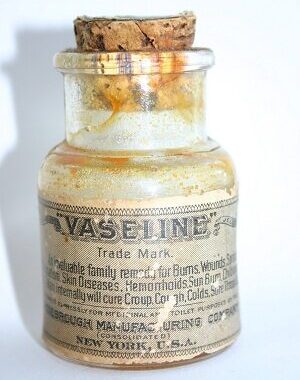
Robert Chesebrough consumed a spoonful of Vaseline each day and lived to be 96 years old. Photo courtesy Drake Well Museum.
When the 22-year-old chemist visited the new Pennsylvania oilfields in 1865, he noted drilling was often confounded by a paraffin-like substance that clogged the wellhead. Drillers used the “rod wax” as a quick first aid for abrasions.
Chesebrough returned to New York City and worked in his laboratory to purify the well byproduct, which he first called “petroleum jelly.” Female customers would discover that mixing lamp black with Vaseline made an impromptu mascara. In 1913, Mabel Williams employed just such a concoction and it led to the founding of a cosmetic company.
Learn more in The Crude History of Mabel’s Eyelashes.

June 4, 1892 – Devastation of Pennsylvania Oil Regions
After weeks of thunderstorms in Pennsylvania’s Oil Creek Valley, the Spartansburg Dam on Oil Creek burst, sending torrents of water that killed more than 100 people and destroyed homes and businesses in Titusville and Oil City. The disaster was compounded when fires broke out.
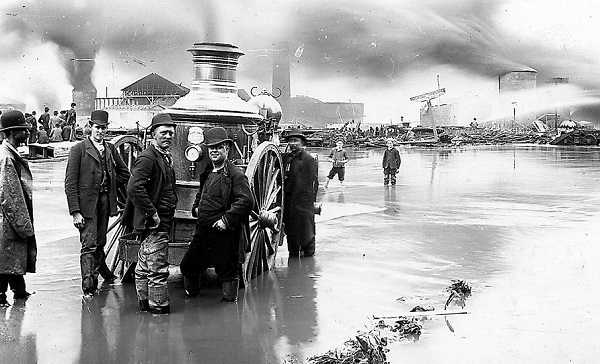
Titusville, Pennsylvania, residents used the “Colonel Drake Steam Pumper” during the great flood and fire of 1892. Photo by John Mather courtesy Drake Well Museum and Park.
“This city during the past twenty-four hours has been visited by one of the most appalling fires and overwhelming floods in the history of this country,” reported the New York Times from Oil City. Oilfield photographer John A. Mather documented the devastation, which included his Titusville studio and 16,000 glass-plate negatives.
Learn more in Oilfield photographer John Mather.
June 4, 1896 – Henry Ford drives his “Quadricycle”
Driving the first car he ever built, Henry Ford left a workshop behind his home on Bagley Avenue in Detroit, Michigan. He had designed his “Quadricycle” in his spare time while working as an engineer for Edison Illuminating Company. Ford chose the name because his handmade, 500-pound “horseless carriage” ran on four bicycle tires. Inspired by advancements in gasoline-fueled engines, he founded the Henry Ford Company in 1903.
June 4, 1921 – Petroleum Seismograph tested
A team of earth scientists tested an experimental seismograph device on a farm three miles north of Oklahoma City and determined it could accurately map subsurface structures. Led by Prof. John C. Karcher and W.P. Haseman, the team from the University of Oklahoma found that seismology could be useful for oil and natural gas exploration and production. Further seismic reflection tests, including one in the Arbuckle formation in August, confirmed their results.

June 6, 1932 – First Federal Gasoline Tax
The federal government taxed gasoline for the first time when the Revenue Act of 1932 added a one-cent per gallon excise tax to U.S. gasoline sales. The first state to tax gasoline was Oregon, which imposed a one-cent per gallon tax in 1919. Colorado, New Mexico, and other states followed. The federal tax, last raised on October 1, 1993, has remained at 18.4 cents per gallon (24.4 cents per gallon for diesel). About 60 percent of federal gasoline taxes are used for highway and bridge construction.
June 6, 1944 – English Channel Pipelines fuel WWII Victory
As the D-Day invasion began along 50 miles of fortified French coastline in Normandy, logistics for supplying the effort would include two top-secret engineering feats — the construction of artificial harbors followed by the laying of pipelines across the English Channel.
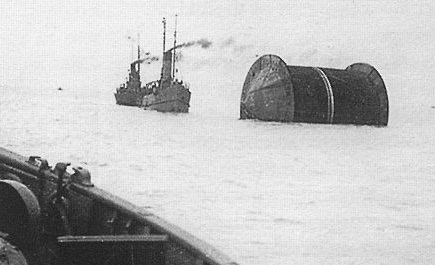
Operation PLUTO (Pipe Line Under The Ocean) unspooled flexible steel pipelines across the English Channel, but the channel was deep, the French ports distant.
Code-named “Mulberrys” and using a design similar to modern jack-up offshore rigs, the artificial harbors used barges with retractable pylons to provide platforms to support floating causeways extending to the beaches.
To fuel the Allied advance into Nazi Germany, Operation PLUTO (Pipe Line Under The Ocean) used flexible steel pipelines wound onto giant “conundrums” designed to spool off when towed. Gen. Dwight Eisenhower later acknowledged the vital importance of the oil pipelines.
Learn more in PLUTO, Secret Pipelines of WW II.
June 6, 1976 – Oil Billionaire J. Paul Getty dies
With a fortune reaching $6 billion (about $32 billion in 2023), J. Paul Getty died at 83 at his estate near London. Born into his father’s petroleum wealth from the Oil Company of Tulsa, Getty made his first million by age 23 from buying and selling oil leases.
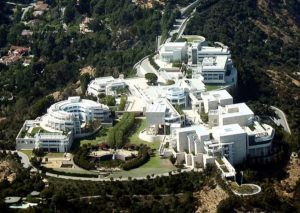
The J. Paul Getty Museum art collection is housed in the Getty Center (above) and the Getty Villa on the California Malibu coast.
“I started in September 1914, to buy leases in the so-called red-beds area of Oklahoma,” Getty once told the New York Times. “The surface was red dirt and it was considered impossible there was any oil there. My father and I did not agree and we got many leases for very little money which later turned out to be rich leases.”
Getty, who incorporated Getty Oil in 1942, gave more than $660 million from his estate to the J. Paul Getty Museum.
______________________
Recommended Reading: History Of Oil Well Drilling (2007); Western Pennsylvania’s Oil Heritage
(2007); Western Pennsylvania’s Oil Heritage (2008); The Maybelline Story: And the Spirited Family Dynasty Behind It
(2008); The Maybelline Story: And the Spirited Family Dynasty Behind It (2010); Around Titusville, Pennsylvania, Images of America
(2010); Around Titusville, Pennsylvania, Images of America (2004); I Invented the Modern Age: The Rise of Henry Ford
(2004); I Invented the Modern Age: The Rise of Henry Ford (2014); Trek of the Oil Finders: A History of Exploration for Petroleum (1975); Code Name MULBERRY: The Planning Building and Operation of the Normandy Harbours
(2014); Trek of the Oil Finders: A History of Exploration for Petroleum (1975); Code Name MULBERRY: The Planning Building and Operation of the Normandy Harbours (1977); The Great Getty (1986). Your Amazon purchase benefits the American Oil & Gas Historical Society. As an Amazon Associate, AOGHS earns a commission from qualifying purchases.
(1977); The Great Getty (1986). Your Amazon purchase benefits the American Oil & Gas Historical Society. As an Amazon Associate, AOGHS earns a commission from qualifying purchases.
_______________________
The American Oil & Gas Historical Society (AOGHS) preserves U.S. petroleum history. Please become an AOGHS annual supporter and help maintain this energy education website and expand historical research. For more information, contact bawells@aoghs.org. © 2025 Bruce A. Wells. All rights reserved.
by Bruce Wells | May 30, 2025 | Petroleum Art
Thousands of glass-negative images document the earliest scenes of America’s petroleum industry.
Soon after the first American oil well in 1859 launched the U.S. petroleum industry in remote northwestern Pennsylvania, an English emigrant began documenting life in the oilfields.
John A. Mather (1829-1915) photographed the people, places and technology from the earliest days of oil exploration. In the fall of 1860, he set up his first studio in Titusville, Pennsylvania — where he would begin to amass more than 20,000 glass-plate negatives.
Oil Creek Artist
Titusville and nearby Oil City and Franklin, in the heart of the growing Pennsylvania oil regions (soon joined by the boom town of Pithole), proved ideal locations for documenting the people, events and evolving drilling technologies of petroleum exploration and production.
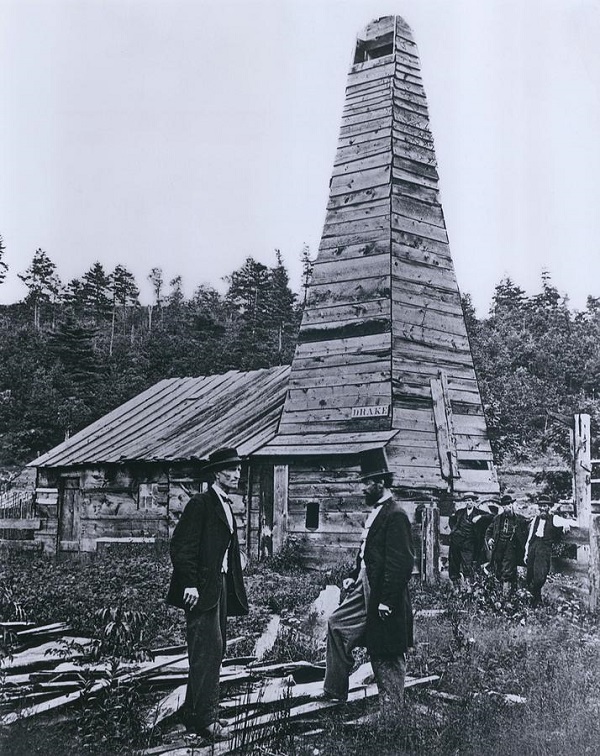
Iconic but often misidentified 1866 photo by John A. Mather features Edwin L. Drake (in top hat) with friend Peter Wilson standing at the rebuilt derrick and engine house of the 1859 first U.S. commercial oil well. Photo courtesy Drake Well Museum and Park.
What Civil War photographers Matthew Brady and James Gardner documented on battlefields, Mather accomplished in Pennsylvania’s oilfields. In 1866, Titusville’s “Oil Creek Artist” photographed the now iconic image of Edwin L. Drake, standing at the original drilling site (rebuilt after the first oil well fire).

Like Brady, Mather abandoned making one-of-kind daguerreotypes and ambrotypes in favor of wet plate negatives using collodion — a flammable, syrupy mixture also called “nitrocellulose.” With one glass plate, many paper copies of an image could be printed and sold.
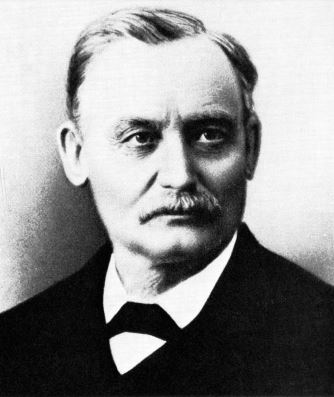
Oilfield photographer John Aked Mather, probably a self-portrait circa 1900.
However, unlike most of the era’s studio photographers, Mather transported his camera and chemicals into the industrial chaos of early Pennsylvania oilfields. But like most people in the new oil region, Mather was susceptible to “oil fever;” he hoped to drill some successful wells himself.
Oil Fever
Above all, the oil regions continued to boom. The gamble of drilling for new oilfield discoveries brought excitement. As “oil fever” spread, polka and waltz song sheets like the Petroleum Court Dance became popular.
Having narrowly missed the opportunity for a one-sixteenth share of the Sherman Well, which proved to be the “best single strike of the year,” Mather and three associates invested in oil wells near booming Pithole Creek. He proved to be better at using a camera.
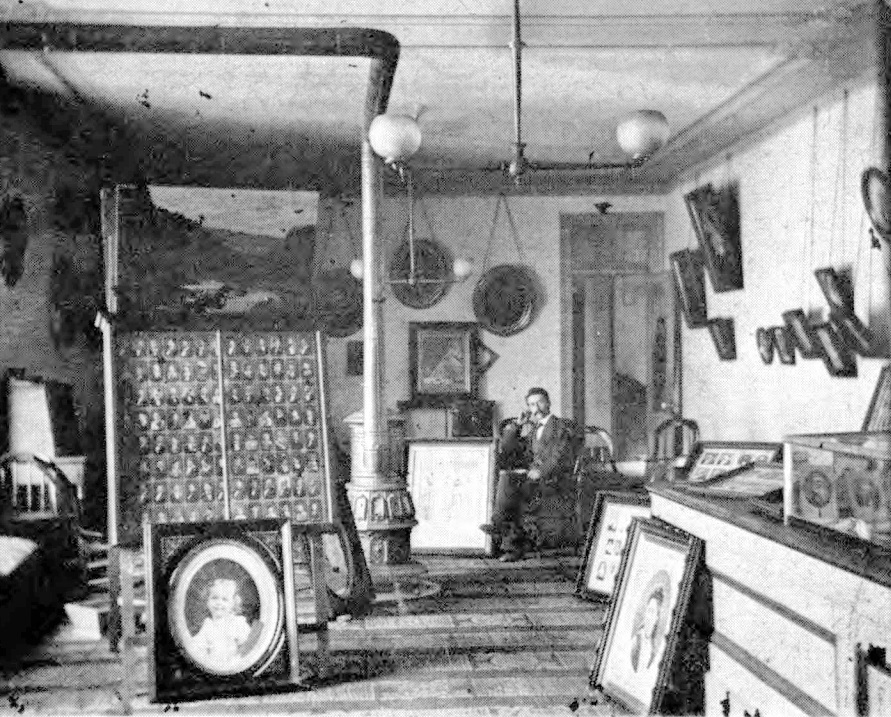
John Mather photographs courtesy Western Pennsylvania Historical Magazine and Drake Well Museum, Titusville. Above, the interior of his Titusville studio, circa 1865.
Mather’s investment in finding oil at Pithole Creek did not lead to producing any commercial quantities. He tried again on the Holmden Farm off West Pithole Creek. His unsuccessful drilling effort proved to be one of the last wells in the infamous boom town Pithole.
Many tried, but few in the increasingly crowded oil regions would rival the wealth of the celebrated “Coal Oil Johnny.” Years later, Mather acknowledged that the excitement of the drilling for “black gold” was so great that he “forsook photography for the oil business.”

Meanwhile, the young U.S. petroleum industry learned some hard lessons. Highly pressurized wells and disasters like the 1861 fatal Rouseville oil well fire brought attention to a new science, petroleum geology.
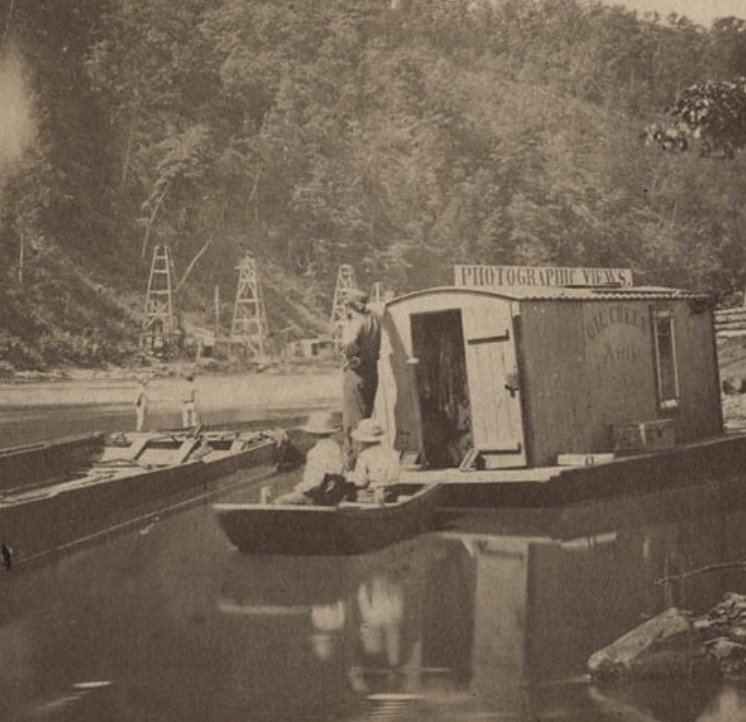
Detail from the 19th-century stereoview “Oil Regions of Pennsylvania,” published by C. W. Woodward of Rochester, N.Y., featuring John Mather’s floating studio and dark room.
Returning to the oilfields with his camera, Mather’s rolling darkroom and floating studio traveled up and down Oil Creek. In 2008, photographic historian John Craig (1943-2011) noted the discovery of a Mather image in a stereoview card published by C.W. Woodward.
“We have had the card for years and assumed that the boat belonged to Woodward,” the historian noted. “When I made the scan I noticed that the side of the boat carried a sign ‘Oil Creek Artist.’ I Googled and found that the studio/darkroom boat belonged to John A. Mather.”
At its peak, Mather’s collection amounted to more than 16,000 glass negatives. The trade magazine Petroleum Age described his oilfield photography as “so perfect in finish it stands the test of time.”
Oil Creek Flood and Fire
On Sunday morning June 5, 1892, and after weeks of rain, Oil Creek’s overflowing Spartansburg Dam failed at about 2:30 a.m. A wall of water and debris swelled towards Titusville and its oil works, seven miles downstream.
“On rushed the mad waters, tearing away bridge after bridge, carrying away horses, homes and people,” one newspaper reported about the flood’s devastation. Then fire erupted from ruptured benzine and oil storage tanks.
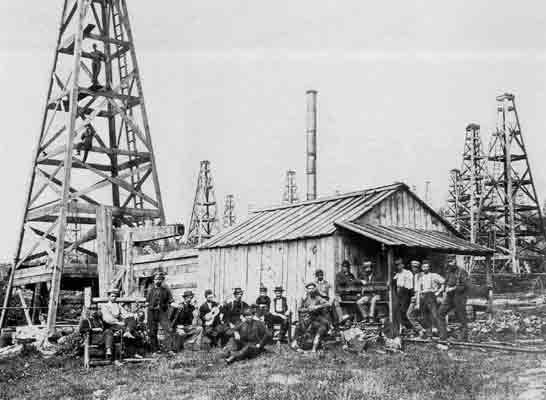
Oilfield workers pose on and among their oil derricks and engine houses in this 1864 John Mather photo from the Drake Well Museum collection in Titusville, Pennsylvania.
Newspapers all over America carried stories of the disaster. In Montana, the Helena Independent headlines included: “Waters of an Overflowing Creek Become a Rushing Mass of Flames” and victims being, “Spared by the Deluge Only to Become the Prey of the Fire.”
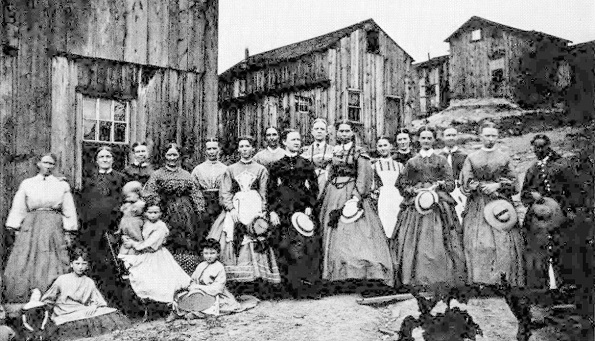
John Mather’s photographs documented family life in remote early oil boom towns. He also briefly caught “oil fever” and unsuccessfully invested in a few wells in the booming Pithole Creek field.
The Brooklyn Daily Eagle added: “The Waters Subside and The Flames Die Away, Revealing the Full Extent of the Calamity.” Oil City and Titusville were “Nearly Wiped From Off the Earth.”

Unfortunately, Mather’s studio flooded to a depth of five feet, destroying expensive equipment — and most of his life’s work of prints from glass plate negatives.
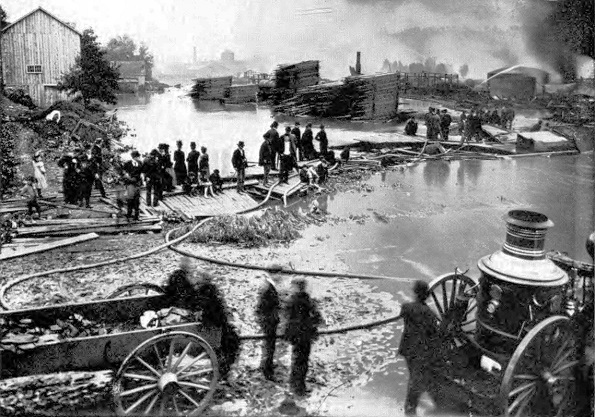
Pennsylvania oil towns were “Nearly Wiped From Off the Earth” by an 1892 fire and flood that destroyed thousands of Mather’s prints and glass plates. Photo from Drake Well Museum collection.
As the fires and flood continued, Mather set up his camera and photographed the disaster in progress with his bulky equipment, which already was being rendered obsolete by new imaging technologies.
Photography Legacy
Just a few years before the Titusville flood, George Eastman of Rochester, New York, introduced celluloid roll film and created an entirely new market: amateur snapshot photography.
Expertise in preparing fragile glass plates and dangerous chemicals was no longer required. Instead, Kodak offered, “You Press the Button, We Do the Rest.”
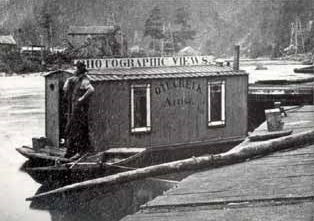
The “Oil Creek Artist” visited potential customers using his floating darkroom.
As oil booms moved to discoveries in other states, including the massive 1901 “Lucas Gusher” in Texas, Mather worked little in his later years. His financial circumstances diminished with age and illness.
The Artist of Oil Creek died poor and without fanfare on August 23, 1915, in Titusville. His death certificate reported the cause as cerebral hemorrhage, “complicated by suppression of urine.”
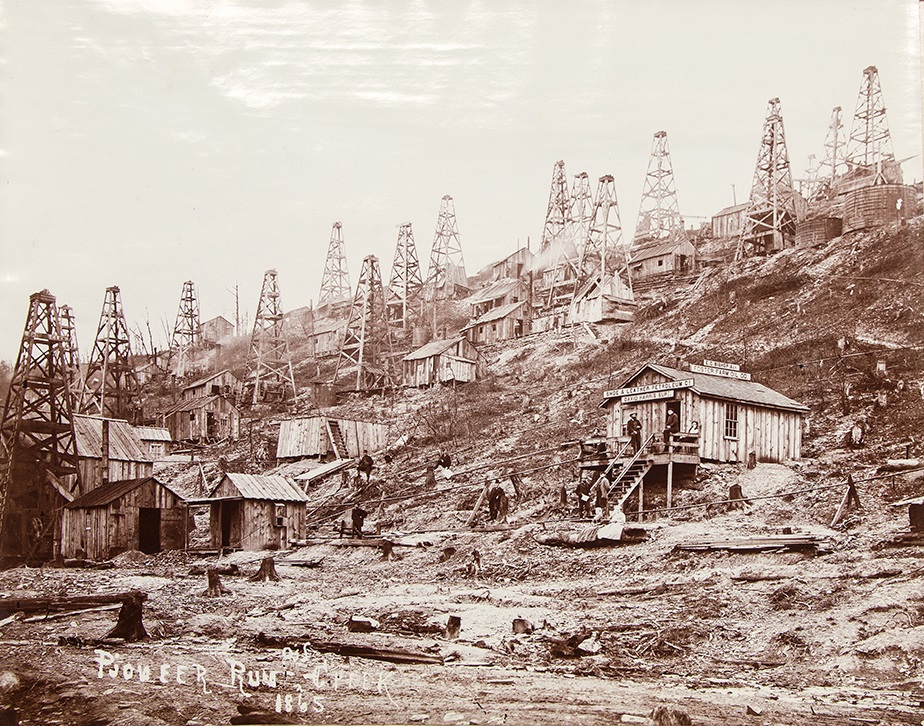
An 1865 John Mather photograph of wooden derricks, engine houses, oilfield workers, an office (and tree stumps) at Pioneer Run – Oil Creek, Pennsylvania.
To preserve John A. Mather’s petroleum industry legacy, the Drake Well Memorial Association purchased 3,274 surviving glass negatives for about 30 cents each.
The Drake Well Museum has preserved the photographer’s surviving work. The museum and surrounding park allow visitors to explore rare artifacts and a visual record of the early U.S. oil and natural industry. Visit the Titusville museum along Oil Creek and other Pennsylvania petroleum museums.
More Resources
“Virtually unknown, certainly unheralded, and completely unappreciated — in these few words is a description of John Aked Mather, pioneer photographer, ” proclaimed Ernest C. Miller and T.K. Stratton in their January 1972 article, “Oildon’s Photographic Historian,” in The Western Pennsylvania Historical Magazine (Volume 55, Number 1).

Born in Heapford Bury, England, in 1829, the son of an English papermill superintendent, Mather joined his two brothers in America in 1856. He soon became “transfixed by the beauty of the Pennsylvania and Eastern Ohio regions,” explains a NWPaHeritage article, adding he developed an “obsessive desire to capture the industry in its entirety.”
_______________________
Recommended Reading: Western Pennsylvania’s Oil Heritage (2008); Around Titusville, Pa., Images of America
(2008); Around Titusville, Pa., Images of America (2004); Cherry Run Valley: Plumer, Pithole, and Oil City, Pennsylvania, Images of America (2000); Myth, Legend, Reality: Edwin Laurentine Drake and the Early Oil Industry
(2004); Cherry Run Valley: Plumer, Pithole, and Oil City, Pennsylvania, Images of America (2000); Myth, Legend, Reality: Edwin Laurentine Drake and the Early Oil Industry (2009). Your Amazon purchase benefits the American Oil & Gas Historical Society. As an Amazon Associate, AOGHS earns a commission from qualifying purchases.
(2009). Your Amazon purchase benefits the American Oil & Gas Historical Society. As an Amazon Associate, AOGHS earns a commission from qualifying purchases.
_______________________________
The American Oil & Gas Historical Society (AOGHS) preserves U.S. petroleum history. Please become an AOGHS annual supporter and help maintain this energy education website and expand historical research. For more information, contact bawells@aoghs.org. © 2025 Bruce A. Wells.
Citation Information – Article Title: “Oilfield Photographer John Mather.” Authors: B.A. Wells and K.L. Wells. Website Name: American Oil & Gas Historical Society. URL: https://aoghs.org/petroleum-art/oilfield-photographer-john-mather. Last Updated: May 30, 2025. Original Published Date: March 11, 2005.


















